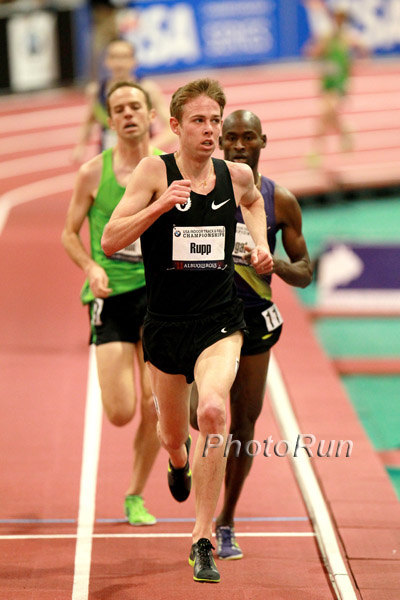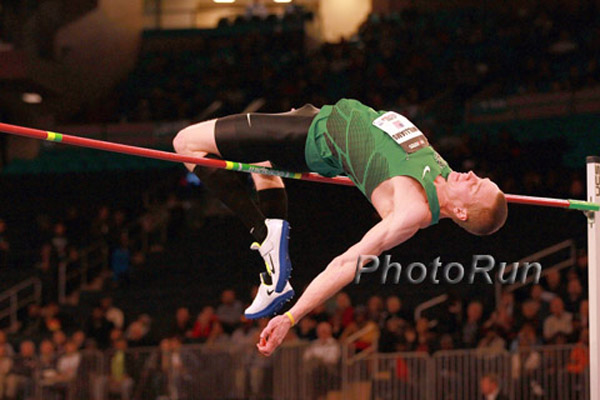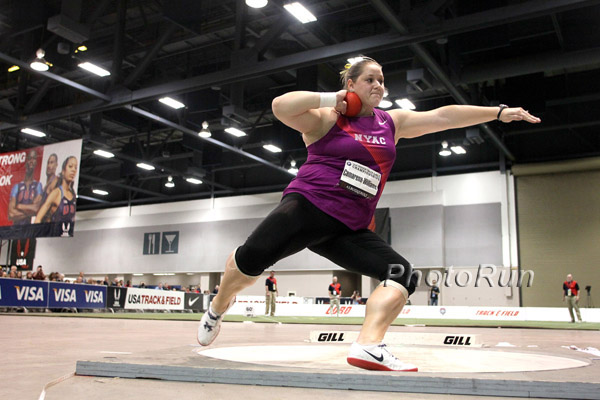This winter has been a fascinating indoor track & field season. While four meets in Europe crashed and burned, the US had two major meetings on one weekend! Hopefully, those date miscues will change, but four ARs in two weekends, (Women’s PV, Jenn Suhr/adidas, 4.88m, 16-0, Women’s shot put, Jillian Camerena-Williams, NYAC/Nike, 19.87m, 65-3.25, Bernard Lagat, Nike, 13:07.15, 5,000m, Galen Rupp, Nike Oregon Project, 2 Miles, 8:09.72), sell out crowds at New Balance Indoor GP and Millrose Games, showed that perhaps we have to change the commercial model.
In 2011-12, the Reggie Lewis Center will hold over 80 indoor track meets, hosting over 150,000 athletes visits. In that same period, the Armory NB Track & Field Center, in NYC, will host just over 100 indoor track events and have 300,000 athletes visits. Both are positive sanctuaries of sport for our young athletes. Both celebrate our sport like few other facilities.
 Galen Rupp, Bernard Lagat, 2011 USA Indoor 3,000m,
Galen Rupp, Bernard Lagat, 2011 USA Indoor 3,000m, photo by PhotoRun.net
Like Nike Pre Classic has been the standard for elite outdoor track meets, the NB Indoor Grand Prix has shown that indoor meets in North America can be both successful financially as well as competitions. In the following article, Dave Hunter proposes an emerging trend in indoor track & field in the U.S. Tell us what you think about it!
Albuquerque
An Emerging Face of U.S. Indoor Track & Field
By Dave Hunter
“What the hell is the matter with indoor track in the U.S.?” How many times have we heard that question being asked? Well, maybe not as much recently. But the inquiry still lingers and the concern and skepticism about the present state and the future of American indoor track and field just doesn’t seem to go away.
In the ’50’s and ’60’s, indoor track in this country was much different. Track meets in cozy – often smoke-filled! – arenas could be found all across the country. In Detroit, there were indoor meets held in Cobo Hall, now razed, where old-school athletes like Ron Jourdan, one of the last of the straddle-style high jumpers – ask your father – and a future Olympian, captured the 1969 NCAA high jump title. In Cleveland, there were the Knights of Columbus Track Meets where Bob Seagren, who twice set the world indoor pole vault record there, nearly grazed the rafters in the dingy old Cleveland Arena. In San Francisco’s Cow Palace, the annual indoor Examiner Games produced esoteric records like Guyana’s Jennifer Innis’ 50 meter dash mark of 6.31 – a South American indoor best she set there in 1983 which still stands today. And who can forget Los Angeles’ L.A. Times Invitational Indoor Track & Field Meet where Jim Beatty, in 1962, ran the first indoor sub-4:00 mile [3:58.9]. Those meets, several of the indoor jewels of a bygone era, are now all gone.
 2012 U.S. Open, Jesse Williams, photo by PhotoRun.net
2012 U.S. Open, Jesse Williams, photo by PhotoRun.netAnd while older track and field fans mourn the loss of these venues and their annual events, a new era of U.S. indoor track and field may well be emerging. Inspired organizers in new cities with greatly-enhanced facilities are seizing the opportunity to fill the void created by the disappearance of these cherished, older meets. Out with the old, in with the new.
One such visionary city is Albuquerque. Gracing the high plains and sporting a pro-active approach to promoting its city and all that it has to offer, Albuquerque is not just sitting back and waiting to be discovered. It’s working hard to make good things happen in its town. One such example is the manner by which the city’s Convention & Visitors Bureau succeeded in landing a three-year contract to host the USATF Indoor Track & Field Championships. In 2007, Dan Ballou, Director of Sports Marketing for the Bureau, traveled to Indianapolis to meet with the leadership of U.S.A. Track & Field to tout the capabilities of Albuquerque and to express the city’s sincere desire to host the indoor championship meet. Impressed, USATF officials made a visit to Albuquerque the next year to view its vibrant core city and to observe the staging capabilities in the city’s 107,000 square foot Convention Center – a site that sports a 200 meter banked Mondo track, can provide a full complement of field facilities, and has spectator seating that accommodates 2400. The serious discussions that ensued led to a three-year contract which awarded the national indoor championship meet to Albuquerque.
It was been a very good three-year run for Albuquerque. Mike McNees, Interim CEO of USATF, has been pleased with the mutually-beneficial relationship that has been created between the governing body and the city of Albuquerque. “Albuquerque has done a fine job as host. And having the meet in their city gives us an opportunity to conduct the indoor championship meet in a location that is a little more convenient for our west coast fan base,” notes McNees. And while McNees and USATF have been pleased, Ballou and Albuquerque are elated. “We feel it [the championship meet] is a valuable asset event for the City of Albuquerque and we hope that USATF feels the same,” offered Ballou. “It is a perfect way to cap off our indoor season.” Ballou cites three major benefits of hosting the championship meet, “First of all, hosting the championship meet is a good resume builder for our city. Secondly, the meet’s presence fuels our hotel night consumption and other direct spending. And, perhaps most importantly, the TV coverage of the meet gives our city invaluable national media attention and exposure.” With economic impact studies confirming that the presence of the championship meet in Albuquerque has a significant, positive impact on direct metropolitan spending, city leadership is in the midst of focused negotiations with USATF to extend the relationship.
 Jillian Camerna-Williams, 2011 USA Indoor Champs,
Jillian Camerna-Williams, 2011 USA Indoor Champs, photo by PhotoRun.net
The success story here and the resulting relationship that has been created between Albuquerque and USATF are reminiscent of a similar relationship shared by the NCAA and Terre Haute, Indiana – host of the NCAA Division I Cross Country Championship races nine times during the past ten years. John McNichols, the long-serving Coordinator and Head Coach of Men’s and Women’s Track and Cross Country at Indiana State University, has played a major role in cultivating this niche and in helping Terre Haute find its identity. “With both the Pre-Nationals Meet and the Div I Cross Country Championship races here, these events bring between 25,000 to 30,000 visitors to Terre Haute and our surrounding area each fall,” notes McNichols. “The positive economic impact for our region is in the millions of dollars.”
The ambitious and visionary strategy employed by Albuquerque and Terre Haute in courting these governing bodies, in securing the rights to host these events, and in achieving the resulting positive impact that has inured to their respective cities is not a tactic that they alone can utilize. Other cities could do this too. And in these challenging recessionary times when relentless economic headwinds continue to buffet many regions of our country, many cities should consider if such an approach might not provide just the type of lift their region needs.
So what about the fortunes of indoor track in the U.S.? With the emergence of upgraded venues in ambitious and visionary new cities like Albuquerque, Seattle, and Fayetteville, it is clear that indoor track isn’t eroding, it’s changing. Even cities with established
indoor track heritages are responding. Boston has re-energized the Boston Indoor Games Prix at the Reggie Lewis Center, attracting a good number of foreign athletes to create a truly international sporting event. (Editor’s note: In fact, the New Balance Indoor Grand Prix, has been the best indoor meet in North America for the past decade).
Even the venerable Millrose Games has made material changes. Many quietly worried that the meet’s departure from Madison Square Garden spelled the beginning of the end. But a boisterous crowd greeted a full complement of athletes at this year’s meet in the Armory – Millrose’s new Manhattan venue. The gathered fans were treated to some indoor magic when Bernard Lagat – The King of the Wanamaker Mile – moved up to the 5000 and raced to a resounding win in an American Record time of 13:07.15. What a perfect way for Millrose’s iconic champion to baptize the meet’s new location!
And so, with an array of forward-thinking cities challenging conventional approaches and leading the way, there is reason for optimism about the future of indoor track and field in the U.S. Expect these newcomers to continue to push the envelope. Buoyed by its recent success, Albuquerque has no plans to rest on its laurels. It is looking toward higher achievements. Its host status with respect to the USATF Indoor National Championships has allowed it in recent years to also attract and host the national Indoor Masters Championships and the NCAA Div II Indoor Championships. “Our goal is to re-invent ourselves,” says Ballou. “We want to be become the Indoor Track Capital of the U.S. And we intend to call ourselves that until we do.” In the past several years, Albuquerque has accomplished much in this area. Will the city achieve its ultimate goal? I wouldn’t bet against them.
[The writer, who can be emailed at: dhunter@brouse.com, has raced in over 90 marathons, including the 1983 B.A.A. Marathon where he set his P.R. of 2:31:40]
Author

Larry Eder has had a 52-year involvement in the sport of athletics. Larry has experienced the sport as an athlete, coach, magazine publisher, and now, journalist and blogger. His first article, on Don Bowden, America's first sub-4 minute miler, was published in RW in 1983. Larry has published several magazines on athletics, from American Athletics to the U.S. version of Spikes magazine. He currently manages the content and marketing development of the RunningNetwork, The Shoe Addicts, and RunBlogRun. Of RunBlogRun, his daily pilgrimage with the sport, Larry says: "I have to admit, I love traveling to far away meets, writing about the sport I love, and the athletes I respect, for my readers at runblogrun.com, the most of anything I have ever done, except, maybe running itself." Also does some updates for BBC Sports at key events, which he truly enjoys. Theme song: Greg Allman, " I'm no Angel."
View all posts


















